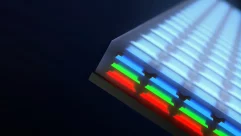
The Green Issue
Jun 2, 2010 10:16 AM, By Cynthia Wisehart
What does it mean for AV?

The LEED standard has charted a compelling path that nevertheless underestimates the potential of green AV.
Infocomm 2010 marks a big step in the greening of the AV industry. As announced at the show, a new sustainability rating system for AV and electronic systems based on the work of InfoComm’s Green AV Task Force and the current AV Sustainability Task Force is open for feedback.
Those of you who have worked on LEED projects or attempted to understand or acquire LEED credits know both the attraction and frustration of the sustainability rating. With its emphasis on the building itself (credits favor such things as recycled carpet) and on carbon-reducing logistical elements such as car-share services (but not videoconferencing), the LEED standard has charted a compelling path that nevertheless underestimates the potential of green AV, indeed green technology of all kinds such as building automation, telecommunications, and IT. For example, while the standard rewards energy efficiency, it does not formalize incentives for the control systems that can maximize a building’s energy management and monitoring.
Scott Walker, president of Atlanta-based Waveguide Consulting, who heads up InfoComm’s AV Sustainability Task Force, knows all this firsthand from eight years of experience on LEED projects. While Walker has earned his stripes as a LEED-accredited professional, he found himself increasingly marginalized from key conversations on LEED projects. “We work on a great many projects where the conversation is all about LEED, and there is nothing we can do because the standard doesn’t really provide for AV,” he says. “After a while, people quit asking us to come to the meetings because they don’t want to waste our time. Where we used to all talk together about technology, now it’s about sustainability, and they don’t even want me at the table. What does that say?”
The perception is that AV is a net energy cost, albeit a minimal one, and little can be done about it to affect the big picture. That is certainly not the case, Walker says. Even beyond that, Walker says AV needs to be seen not just as an impact to be mitigated but also as an instrumental tool for increasing a building’s sustainability solution and culture. InfoComm pursued this objective in part through combined efforts with other technology trade associations including Continental Automated Building Association (CABA), Building Industry Consulting Service International (BICSI), and the Telecommunications Industry Association (TIA). But that wasn’t clicking for the United States Green Building Council (USGBC); it was focused on other priorities, and technology wasn’t in the frame, Walker explains.
However, on the core idea—that a ratings system can drive innovation and opportunity, and formalize progress toward a larger goal—LEED broke trail and proved the point. InfoComm is now developing a standard for power management for submission to the American National Standards Institute (ANSI), as well as the sustainable technology rating system that will focus initially on AV but is open for other associations and industries to join.
“We estimate that 66 percent of the rating system is universal to electronic systems from many industries,” says Randal Lemke, executive director and CEO of InfoComm. Further, the rating system was developed with an open architecture that allows other industries to bring their criteria into the system. InfoComm is talking with other associations and working to form a coalition of commercial electronic industry associations to help its members use the rating system.
“When InfoComm started working seriously on green in 2007 and 2008, our initial goal was to develop a green AV body of knowledge and highlight best practices, but it was hard to create a body of knowledge if there are no definitions; we were at the root level rudderless,” Walker says. Best practices alone, he says, were not enough; a ratings system, with benchmarks and scores to achieve, was a crucial component. “Then you have a target and a definite way to design your systems as well as market your work.
Walker wants people to understand that the standard is not only about limiting or reducing technology or impact—“for everything in the rating system that could be seen as limiting future sales, there’s another element that promotes new sales,” he says.
That said, the point of the current version unveiled at InfoComm is to elicit honest feedback for revisions. “You’re going to see a work in progress,” he says. “It’s going to take more than the 10 of us [on the Task Force] to figure this out.” Walker says the configuration of the task force deliberately includes manufacturers, integrators, and consultants, the whole “biosphere of AV”—and eight of the 10 members are LEED-accredited professionals. “But we need more than two representatives of each viewpoint.”
Once the rating system is established, the next hurdle is to get owners to ask for it in requests for proposal (RFPs) and to aspire to that level of sustainability. Once the owners begin to demand it, as they have done with LEED, innovation will follow, as well as opportunity for those who can differentiate their business based on green expertise.
“It changes how you do your work and how you sell your business,” Walker says. “We will be trying to out-green each other, and that’s a good thing. The question is: Will we be part of the problem that needs to be eradicated or part of the solution that needs to be amplified? When our systems are seen as part of the intelligence of the building—part of driving efficiency, managing and monitoring resources, and supporting greener business practices—we’ll be back at the center of the table.”
The Green Issue
Jun 2, 2010 10:16 AM, By Cynthia Wisehart
What does it mean for AV?

Walking the Talk
Not everyone in AV is behind the green curve. Christie Digital’s four-year path is a case study in the rippling effect of greening a business. Not only has the company been honored for its green practices, this year it was named one of the Best Employers for New Canadians by the editors of Mediacorp. Green is not merely an add-on initiative but an integrated philosophy of efficiency and employee engagement; it has come to influence everything from R&D investment to summer Fridays (free ice cream for everyone to offset the thermostat setting).
Christie President and COO Gerry Remers says the seeds of green transformation came from the culture of its parent company, Ushio, which is in the top 5 percent of companies in Japan’s Nikkei Environmental Management Survey and from a key environmental event in Europe—the bold and sweeping Restriction of Hazardous Substances (RoHS) Directive, which went into effect in the summer of 2006. In business terms, RoHS was effectively an overnight ban on six vital electronics manufacturing substances including lead, mercury, and cadmium. RoHS proved that swift and dramatic change was possible, and Remers says that once Christie started down the environmental awareness path, the company never looked back.
“I understand that some may see a dichotomy in the fact that we make a product that consumes 6kW of power and then talk about being a green company,” Remers says. But, he explains, the picture is more sophisticated than that. Digital projectors are a big improvement environmentally over celluloid ones, and like many products in AV, constant technological advancements have produced significant gains in lumens per watt—a trend that will only continue as LED light sources continue to mature. More importantly, Christie’s environmental strategy demonstrates how much can be accomplished in a manufacturing setting, regardless of the product or byproducts of the business. It’s a three-dimensional equation, a new way of looking at business, cost, and value to the customer and the company’s employees and community.
In 1998, Christie’s Peter Pekurar started building the company’s quality management system, so it was a logical step for him to develop and integrate an environmental management system starting in 2006. His admittedly awkward title, senior manager of integrated management systems, reflects just how interdependent environmental management, quality, and business now are at Christie.
“We started internally in our use of materials, recycling, energy use, and emissions,” he explains, “because it was the best way to raise awareness, so every individual would think in terms of green in everything they do.”
“We’re an engineering company, and engineers tend to be well-educated; they’re very concerned about working for a good company stands for corporate responsibility. You have to walk the talk,” Remers says. Internal policies included a four-day week for up to 180 floor workers, green parking, a sophisticated recycling program, less paper, less travel, and continuous education and awareness about efficiency and waste.
The starting point, Pekurar says, was the ISO 14000 standard and its environmental aspect list. “It’s like a risk-based analysis of where you as a company touch the environment and have an opportunity to negatively impact the environment,” Pekurar says. “Our aspect list is 100 lines long. We apply a risk, value, and frequency, and come up with a rating for each aspect. The list allows you to distinguish between significant aspects—in our case, the regulations we had to comply with, recycling, and emissions. You also designate normal aspects for the things that are lower-impact and so lower-priority. Dollars do not come into it, but if you do a good job on addressing these aspects, the organization becomes more functional and efficient, and therefore more profitable. We realized benefits and savings that we didn’t intend.”
Both the Kitchener, Ontario, and Cypress, Calif., facilities are ISO 14000, and Remers and Pekurar say that basic culture became the foundation for more green innovation and outreach. That translates into manufacturing and R&D.
“You want to ensure that the products use recyclable parts, ensure they’re efficient,” Remers says. “You want to track your supply chain for efficiency and waste reduction. Your product is hopefully brighter than competitors’, so you want your optical systems as efficient as possible. You want lean development. We should never be air freighting, especially things that weigh 800lbs., but we do, so we look at our planning process to reduce that. Efficiency and green are part of the same coin.”
“It’s very expensive to handle waste, so it’s important to make as little of it as possible,” Pekurar says. “You develop an awareness of what constitutes waste, both on the input and the output side. Everything in the stream should be adding value to the customer—that’s why environmental management and quality management work together, because that allows you to add value in a way that minimizes environmental load and cost. Going green should not be costing you money. It should be saving your customers money.” Good green is profitable.
But make no mistake; going green is like many other business strategies. Initially it is an investment, especially in education. And Pekurar spends significant time reinvesting in educating the larger communities—both his local business community and the AV community. He sits on the committee that is developing the ANSI energy management standard for the effective use of energy in AV installation.
Both Pekurar and Remers are also active in the movement toward third-party verification of product claims, much as Energy Star is doing. “Version 2 of the ISO 21118 projector spec is quite exciting,” Pekurar says, because it moves away from what has largely been voluntary claims and self-declaration.
“It’s important for companies to understand this is not going away; it is not a fad,” Pekurar says. “Our entire economy is based on using and recycling resources.
“It’s also important to understand that this is about developing a culture, making it fun,” Pekurar says. “In terms of marketing it to our employees, it was one of the most successful programs we’ve ever done. In fact, part of the program has been educational events that help employees think about healthy homes and energy-efficient lifestyles that reach beyond work.”
“It’s not our intention to lead the green charge to create a brand or a green aura,” Remers says. “It’s based on values and doing the right thing. It’s fundamental that we should not be wasteful and we should be on a path of continuous improvement. And engineers like elegant solutions—an efficient, elegant supply chain, efficient design, efficient circuit boards. There is a strong tie between aesthetics and efficiency.
“Going green, if you want to call it that, is part of the overall running of a business. Corporate responsibility proves the viability and sustainability of your business.”
Going Green Resources
READ
- Green to Gold: How Smart Companies Use Environmental Strategy to Innovate, Create Value, and Build Competitive Advantage,By Daniel C. Esty and Andrew S. Winston
- Cool Companies: How the Best Businesses Boost Profits and Productivity by Cutting Greenhouse-Gas Emissions, By Joseph J. Romm
- Sustainable Value: How the World’s Leading Companies Are Doing Well by Doing Good, By Chris Laszlo
- The Sustainability Advantage: Seven Business Case Benefits of a Triple Bottom Line, By Bob Willard
- Cradle To Cradle: Remaking the Way We Make Things, By William McDonough and Michael Braungart
JOIN
Check out InfoComm’s Green AV Special Interest Group (SIG), part of InfoComm’s members-only social networking community, at infocomm.org. Updates on the sustainability rating system will be available here, as well as other green AV related information and opportunities.










